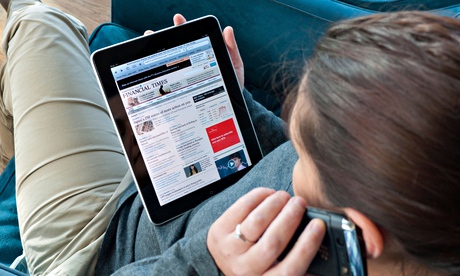
Something significant happened under cover of pinkness while we were busy agonising over Scotland and Ed Miliband's dodgy memory. The Financial Times emerged redesigned: new type, new column widths, new colour graphics. What's significant about that, you say? Papers have fiddled and fettled throughout history. But this time the changes meant so much more. They cost many thousands of pounds, hard cash and hard choices – and they challenged the whole current orthodoxy of print life and death.
Newspapers, remember, are supposed to be dying fast – on a transition road to digital survival or oblivion. Transition is the mantra of the age, and the FT, gaining online subscriptions hand over fist, making big website money here and now, is by some lights the most successful exponent of this transforming state.
Yet here's chief executive John Ridding on the importance of a redesign that "underscores our confidence in the unique and lasting value of print, which is profitable on its own, before advertising". It is "an important part of our multi-channel offering for many readers, who increasingly consume our journalism is multiple formats".
Mario García, one of the world's most illustrious designers of papers (including the Observer, once), makes the essential point. "One salient element of the FT redesign isn't necessarily visible on the pages: a commitment to print." By investing in the print edition, the FT "is sending a message that its print product is here to stay and that what it's doing is redefining its role".
And you can make much the same case for the Guardian's emerging policy, pursued again this autumn, of expanding sections and adding services, with TV promotion attached – as well as pounding along digital pathways. Last week the new editor of the New York Times, announcing sundry reforms, hailed "the majesty of print" (so echoing his Murdoch rival's recent praise for "the power of print"); and you can see why when you look out across the profound uncertainties of digital existence. Because, increasingly, publishers aren't talking one or the other. They are talking both.
That's the agenda for FT change, producing a look and style that unites page and screen as part of an each-way bet. It is where the Times in Britain finds itself at the moment, with print sales in the UK marginally up year-on-year, full-price sales a few thousand ahead as well – and 390,000 paying "members" claimed on its homepage.
A few months ago, the CEO of The Week magazine was busy putting digital (in his case, tablet versions) in a proper context. "When the iPad launched, most publishers thought about tablets; but that only worked for about a year and a half," he said. "Now it is all about the phone. In two years it could be something else. Our strategy is publish once, publish everywhere" – a strategy that sees The Week putting on print sales as well as 26,000 digital subscriptions. "Both" can mean advance on every front.
Of course there are bucketfuls of chill gloom on tap as well. Last week Moody's in America saw digital subscription growth flattening then shrinking, digital ad hopes fading fast, search engines and video sucking away desperately needed dollars. But this, remember, is in a US context where too often the answer isn't "both" but "neither" – a separate world where great media chains have carved their empires into two and left the old newspaper territory saddled with bad vibes and often bad debt burdens. Failure: more or less guaranteed. Optimism and forward thinking: nil.
Maybe you can make Wall Street happy if you artificially burden the stragglers and cast them adrift. Maybe you can make perfectly decent profitability look puny by the standards of 20 years ago. But that's not where the real action is now. Only two, let alone 20, years back, the prophets of online hegemony made transition seem inevitable – for papers, magazines, books. Today, ebook growth seems to have hit an unexpected wall, while print book sales hold up far beyond expectation. Today, new magazines can be started and even sometimes watch sales grow while tablets themselves fall from favour. Today the most successful newspapers in print find different ways of surviving online. (Try 180 million unique browsers a month for the Mail.)
Once upon a quite recent time, it all seemed pretty simple. One out, one in. Goodbye Caxton, hello Steve Jobs. But tomorrow? Hello pinkness, my old friend …

